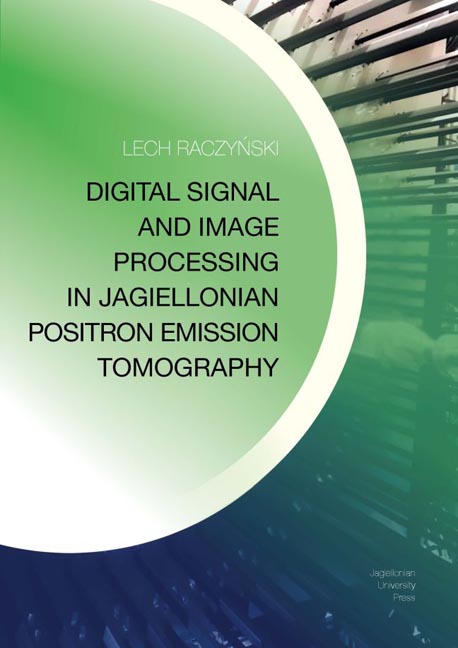Book contents
- Frontmatter
- Dedication
- Acknowledgements
- Contents
- Abbreviations
- Preface
- 1 Introduction
- 2 Positron Emission Tomography
- 3 Algorithmic background
- 4 Low-level data processing in Jagiellonian PET
- 5 High-level data processing in Jagiellonian PET
- 6 Results
- 7 Conclusions and summary
- Appendix
- References
- Miscellaneous Endmatter
- Frontmatter
- Dedication
- Acknowledgements
- Contents
- Abbreviations
- Preface
- 1 Introduction
- 2 Positron Emission Tomography
- 3 Algorithmic background
- 4 Low-level data processing in Jagiellonian PET
- 5 High-level data processing in Jagiellonian PET
- 6 Results
- 7 Conclusions and summary
- Appendix
- References
- Miscellaneous Endmatter
Summary
Experimental and simulation scenarios
For the evaluation of the proposed data processing algorithms described in chapters 4 and 5, both experimental and simulation data of the J-PET scanner were used. The performance of the low-level signal processing methods, presented in chapter 4, is investigated by using a data set of reference signals registered in a single module scintillator strip of the J-PET detector. This experimental setup is described in section 6.1.1. The quality of the high-level data processing methods, introduced in chapter 5, is examined by using both experimental and simulation data. The experimental scenario describing the 3-layer prototype J-PET scanner is shown in section 6.1.2 and the simulated 1-layer J-PET detector is introduced in section 6.1.3.
Experimental scheme with 1 scintillator strip
In this section we introduce the scheme with single detection module of J-PET device that allows the investigation of low-level data processing described in chapter 4. The scheme of the experimental setup is presented in Fig. 6.1.
The single detection module is built from the BC-420 plastic scintillator strip, with dimensions of 5 × 19 × 300 mm, readout at two ends by Hamamatsu R4998 photomultipliers is denoted as PM1(2). Measurements are performed using γ photon from a 22Na source placed inside the lead collimator between the scintillator strip and the reference detector. The reference detector consists of a small scintillator strip with a thickness of 4 mm. A collimated beam emerging through a slit 1.5 mm wide and 20 cm long is used for irradiating desired points across the strip. In order to detect the event, coincident registration of signals from the PM1 and a reference detector is required. Such trigger conditions reduce the background from the deexcitation photon (1.27 MeV) to a negligible level [17]. The time of triggering by the reference detector is used to estimate the event arrival time. The constant electronic time delay between the true event time and the measured time of arrival at the reference detector does not influence the time and spatial resolutions and is shifted to zero. The full waveforms of signals on PM1 and PM2 are sampled using the Lecroy SDA 6000A oscilloscope with a sampling interval of 50 ps.
- Type
- Chapter
- Information
- Publisher: Jagiellonian University PressPrint publication year: 2021



